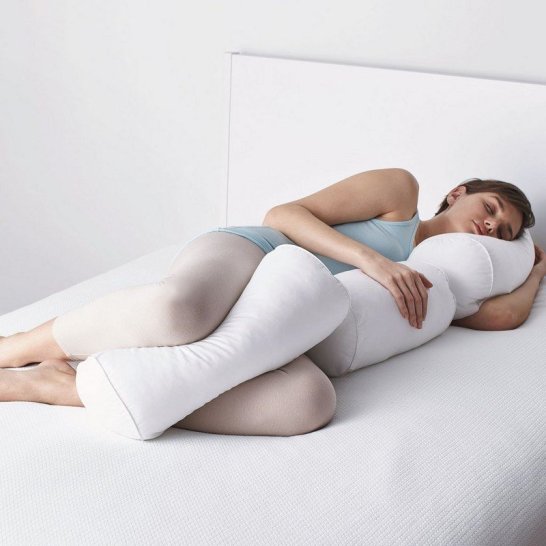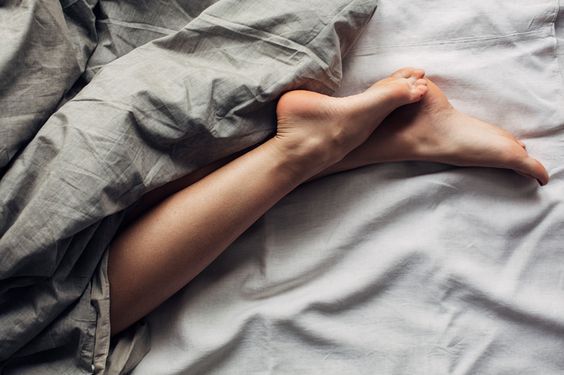Sciatica affects millions of people worldwide. Pain in the lower back and legs can be a symptom of Sciatica, and it can make everyday things like sitting, walking , or sleeping become uncomfortable for you. Knowing how to sleep with Sciatica is especially difficult!
But, although it seems impossible to get a good night’s sleep with the pain, there are things you can do to help relieve your Sciatic pain and sleep well throughout the night.
How Does Sciatica Affect Your Sleep?
The reason Sciatic pain gets intense at night is because you are putting a large amount of pressure on the Sciatic nerve. This nerve is one of the thickest in your body, and it runs from the spine down the leg. You have two of these nerves, one for each leg.
When you’re laying down in a normal sleeping position, you will be putting pressure on your back, legs, and hips in such a way that the Sciatic nerve gets stressed and produces pain.
Here is a helpful video about Sciatica and how it causes pain when you lie down to sleep:
What Can You Gain By Learning To Sleep With Sciatica?
If you learn some of the best sleeping positions for Sciatica pain, you can actually relieve the pain and sleep peacefully throughout the night. Learning how to sleep with Sciatica may take some trial and error, but after you spend a night without waking up from the pain, you will be glad that you did it!
How to Get the Best Sleep with Sciatica
Here are a few great tips on how to sleep with Sciatica. Try each one for a few nights until you find a method that really works for you and relieves the pain.
- Bend Your Knees
Sciatica pain is caused when the Sciatic nerve around your lower back becomes irritated by pressure put on it. When you’re sleeping is usually when you put the most pressure on your lower back, especially if you’re not in the right position.
- Sleep with a Wedge or Body Pillow
Related to the first point, there are a few ways you can ensure that your body stays in an ideal position while you’re sleeping. Using foam wedges and body pillows can help you to properly align your spine to relieve pressure on all points. This leads to very comfortable sleep, even if you suffer from Sciatica-related back pain.

Foam wedges are useful when you’re sleeping on your back. You put one under your knees to make your spine open up and release the pressure from your Sciatic nerve.
This allows you to sleep without putting any pressure on that nerve and feeling the strong pain. If necessary, put another pillow on top of the wedge to make your knees bend more.
Body pillows have a similar job as wedges, but they work for side sleepers instead. There are three types of body pillows: Straight rectangles, J-shaped, and U-shaped pillows. All of them can give you some relief if you use them between your legs when you sleep on your side, but U-shaped pillows are the best for Sciatica pain relief.
A U-shaped pillow tucks around your front, back, between your legs, and under your neck. It supports your entire body and keeps you from rolling over into an uncomfortable position as you’re sleeping.
Here are a few U-shaped body pillows you can check out:
- Leachco Back N’ Belly Contoured Body Pillow
- Comfort U Total Body Pillow
- Choose a Harder Mattress

Via sleep.org
When your mattress is too soft, it won’t provide the level of support you need for your back. It’s better to opt for a harder mattress made from materials like firm memory foam than rather than taking a soft and squishy mattress.
You can get a mattress topper for a quick fix to this, but make sure it’s a firm one and not just another way to soften your bed. Soft mattresses do not provide the level of support your back and hips need, and will always cause you more pain than they are worth.
- Relieve Pain Before Going to Bed
Something else that can help you when you’re suffering from Sciatic pain is to do a pain relief activity before you go to sleep. This will lessen any pain you are feeling while trying to sleep and help you get more comfortable quickly. Try a few home pain relief methods that can work for Sciatica.

Via verywell.com
The first things you can try are yoga or stretching exercises that target the buttocks, legs, and lower back.Another method of relieving Sciatic pain is through massage. If there is no one there to give you a massage, put a tennis ball under your hip and buttocks and roll around on it.
You can also put a heat pack or ice pack on the pained area to help relieve pain. If you prefer, a hot bath will also do the trick for heat therapy purposes. Anti-inflammatories can also help to relieve pain from Sciatica.
Pro Tips For Getting Better Sleep
Here are a few extra tips about relieving your Sciatica pain:
- Avoid Sleeping on Your Stomach
Sorry, stomach sleepers, but there’s no way around this. Sleeping on your stomach is horrible for your back and neck, and it can exacerbate any existing pain you might be feeling from Sciatica. Sleeping on your back or side is much better for your comfort and spinal health.

Via wsj.com
- Make The Adjustment To A New Sleeping Position Easier
Do whatever you have to in order to help yourself get comfortable sleeping in the best position for your pain. If you’re not used to sleeping on your side, make sure you make your room the most comfortable environment possible before you try to fall asleep on your side the first few nights. This is going to make the transition much easier and help you feel more comfortable with your new position.

Via domain.com.au
- Keep Yourself from Rolling to the Wrong Side at Night
Sometimes when your Sciatica pain shows up on one side of your body more than the other it is very uncomfortable to sleep on that side. For this reason, you should keep yourself from rolling to that side as you’re sleeping.
Do this using a full-body pillow or putting a tennis ball in the pocket of the side you don’t’ want to sleep on. Both methods can work to help keep you from rolling over while you’re snoozing.
Conclusion
It’s not always easy learning how to sleep with Sciatica, but it can be worthwhile to try some of the methods I’ve talked about above. If anything ends up working well for you, then you can be virtually pain-free every night instead of having to endure the sharp, stinging pains from your Sciatica !
Do you have anything to add? Have you ever tried any of these techniques to help you sleep? I’d love to hear what you have to say in the comments below !
